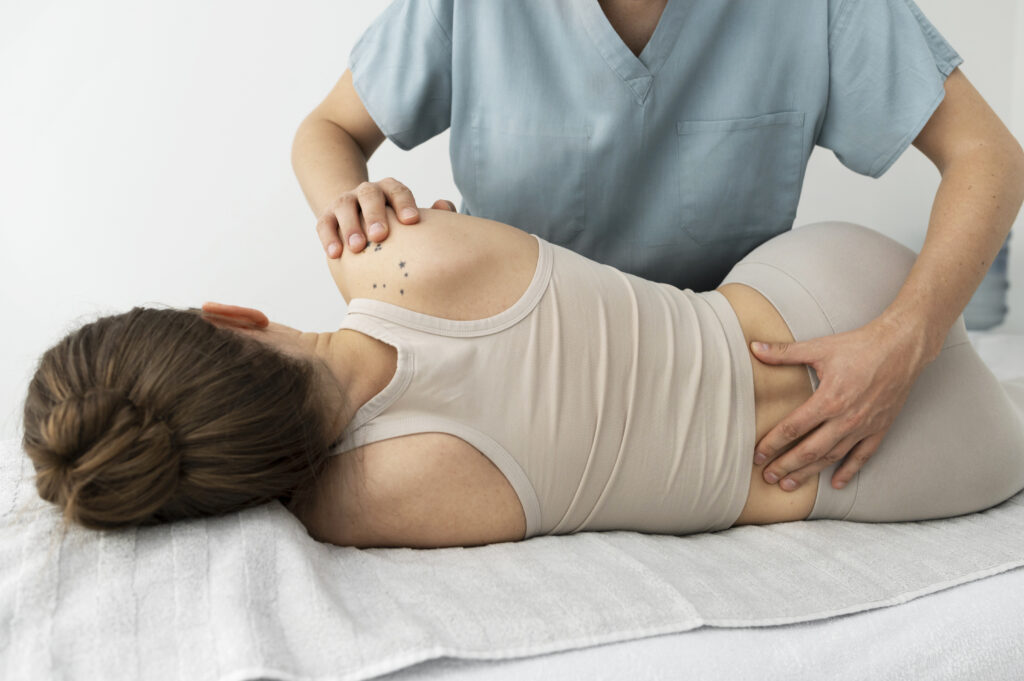You might not realize how much your joint flexibility impacts your overall movement and well-being. By focusing on targeted stretching, mindful practices, and proper nutrition, you can enhance your range of motion and reduce the risk of injuries. It's not just about exercising; it's about creating a sustainable routine that listens to your body's needs. As you explore effective techniques and lifestyle adjustments, you'll discover the subtle yet profound changes that can occur. What specific strategies can you implement to start this journey toward improved mobility?
Understanding Joint Flexibility
When you think about joint flexibility, imagine how easily you can move your arms, legs, and spine without discomfort. Joint flexibility refers to the range of motion in your joints, which is essential for performing daily activities and maintaining overall physical health. It's not just about being able to stretch or bend; it involves the intricate interplay of muscles, tendons, ligaments, and the joint capsule itself.
You might notice that some people can easily touch their toes or perform deep squats, while others struggle with basic movements. This variation often stems from factors like genetics, age, and activity level. As you grow older, your joints may naturally lose some flexibility, making it vital to incorporate practices that promote mobility.
To enhance your understanding of joint flexibility, consider the role of the synovial fluid found in joints. This viscous fluid lubricates the joint, reducing friction and allowing for smoother movements. Additionally, the surrounding muscles and tendons need to remain adaptable. If they become tight or stiff, they can restrict your range of motion.
Engaging in regular stretching and mobility exercises can help maintain or improve your joint flexibility. Activities like yoga or Pilates focus on flexibility and can be beneficial for your joints.
Benefits of Enhanced Movement
Enhanced movement brings a multitude of benefits that can greatly improve your quality of life. When you enhance your movement abilities, you boost your overall physical health, which can lead to increased energy levels and better daily performance. You'll find that simple tasks, like climbing stairs or carrying groceries, become easier and less taxing on your body.
Moreover, enhanced movement helps reduce the risk of injuries. By improving your flexibility and joint function, you create a more resilient body that can better withstand the demands of everyday activities. This means fewer sprains, strains, and other injuries that can sideline you and disrupt your routine.
Additionally, enhanced movement contributes to better posture and alignment. When your joints and muscles work harmoniously, you'll notice improvements in your posture, which can alleviate pain in your back and neck.
As you move more freely, you'll also experience increased circulation, promoting better blood flow and oxygen delivery to your muscles and organs, further supporting your overall wellness.
Mental health benefits shouldn't be overlooked either. Engaging in activities that promote enhanced movement can boost your mood, reduce anxiety, and increase feelings of happiness. The physical activity stimulates the release of endorphins, enhancing your overall emotional well-being.
Effective Stretching Techniques
To achieve the benefits of enhanced movement, incorporating effective stretching techniques into your routine is key. Stretching not only improves flexibility but also prepares your muscles for activity, reducing the risk of injury.
Start with dynamic stretches, which involve controlled movements that gently take you through your range of motion. Think arm circles, leg swings, or torso twists. These help warm up your body and increase blood flow to your muscles.
Once you've warmed up, shift to static stretching. Hold each stretch for about 15-30 seconds, focusing on major muscle groups like your hamstrings, quadriceps, and shoulders. Remember to breathe deeply during each stretch to help your muscles relax. For instance, try sitting on the floor and reaching for your toes to stretch your hamstrings.
It's essential to listen to your body. You should feel a mild tension during stretching, but never pain. If something doesn't feel right, ease up or modify the stretch. Incorporating a variety of stretches targeting different areas can also be beneficial.
Finally, consider adding flexibility routines like yoga or Pilates to your weekly schedule. These practices not only enhance joint flexibility but also improve overall body awareness.
Role of Nutrition in Joint Health
When it comes to maintaining healthy joints, nutrition plays a vital role.
You need to focus on essential nutrients, anti-inflammatory foods, and proper hydration to support flexibility and movement.
Let's explore how these factors can enhance your joint health and overall mobility.
Essential Nutrients for Joints
Nourishing your joints with the right nutrients is fundamental for maintaining their health and flexibility. Key players in joint health include omega-3 fatty acids, which reduce stiffness and improve mobility. You can find these in fatty fish like salmon and walnuts.
Next, antioxidants like vitamins C and E play an important role in combatting oxidative stress, which can damage joint tissues. Citrus fruits, berries, and green leafy vegetables are excellent sources of these vitamins.
Don't forget about collagen, a protein that helps maintain cartilage integrity. Bone broth or collagen supplements can boost your intake.
Additionally, vitamin D is essential for calcium absorption, promoting strong bones and preventing joint pain. You can get this from sunlight exposure or fortified foods.
Minerals like magnesium and zinc also contribute to joint health. They support muscle function and repair, helping you maintain an active lifestyle.
Aim for a balanced diet rich in whole foods to guarantee you're getting these necessary nutrients. With the right nutrition, you can support your joints, enhancing your overall movement and flexibility.
Anti-Inflammatory Foods Benefits
Incorporating anti-inflammatory foods into your diet can markedly enhance joint health and mobility. These foods help reduce inflammation, which is often a culprit behind joint pain and stiffness. By focusing on what you eat, you can support your body's natural healing processes and enjoy greater flexibility.
Fruits and vegetables, particularly berries, leafy greens, and citrus fruits, are rich in antioxidants and compounds that combat inflammation. Omega-3 fatty acids, found in fatty fish like salmon, walnuts, and flaxseeds, also play a crucial role in reducing joint discomfort.
Don't forget about spices like turmeric and ginger, known for their powerful anti-inflammatory properties. Even whole grains, such as brown rice and quinoa, can contribute to better joint health by stabilizing blood sugar levels and reducing inflammation.
Hydration's Impact on Flexibility
Proper hydration plays an essential role in maintaining flexibility and overall joint health. When you're well-hydrated, your joints function more smoothly, allowing for better movement and less discomfort. Water is key for lubricating joints and keeping the cartilage cushioned, which helps prevent stiffness and injury.
Here are some important reasons to stay hydrated for joint health:
- Improved Lubrication: Water helps maintain synovial fluid, which lubricates joints and reduces friction during movement.
- Enhanced Nutrient Transport: Proper hydration aids in delivering essential nutrients to joint tissues, promoting healing and flexibility.
- Reduced Inflammation: Staying hydrated can help decrease inflammation in the joints, alleviating pain and stiffness.
To optimize your flexibility, make it a habit to drink enough water throughout the day. Pay attention to your body's signals; if you're feeling thirsty or fatigued, it's a sign you need to hydrate.
Incorporating Mindfulness Practices
Incorporating mindfulness practices can transform your approach to joint flexibility and overall movement care.
By focusing on mindful movement techniques and breath awareness, you'll enhance your body's awareness and improve your range of motion.
Let's explore how these practices can support your joint health and elevate your physical experience.
Mindful Movement Techniques
Mindful movement techniques blend physical activity with awareness, creating a holistic approach to joint flexibility and overall wellbeing. These practices encourage you to connect your mind and body, fostering a deeper understanding of your movements.
By incorporating mindfulness, you can enhance your flexibility while reducing stress and promoting relaxation.
Here are three key benefits of mindful movement:
- Increased Body Awareness: You become more attuned to your body's signals, helping you identify areas of tension and restriction.
- Improved Coordination: With focused attention, your movements become smoother and more controlled, reducing the risk of injury.
- Enhanced Mind-Body Connection: Engaging in mindful practices strengthens your relationship with your body, allowing for more intentional and purposeful movement.
To get started, consider activities like yoga, tai chi, or simply walking with awareness.
As you practice, focus on each movement, noticing how your joints feel and adjusting as needed. This approach not only promotes flexibility but also nurtures a calm and centered mind, making your physical activity more rewarding.
Embrace these techniques, and you'll likely notice significant improvements in both your joint health and overall wellbeing.
Breath Awareness Practices
Breath awareness practices, when combined with mindfulness, can significantly enhance your experience of movement and flexibility. By tuning into your breath, you create a deeper connection between your mind and body, allowing you to move with greater ease.
Start by finding a comfortable position, whether seated or standing. As you inhale, feel your chest and abdomen expand, and as you exhale, notice the gentle release of tension.
Incorporate breath awareness into your daily movements. When stretching or exercising, synchronize your breath with each motion. Inhale as you lengthen your body, and exhale as you fold or release. This rhythm not only improves flexibility but also enhances your focus, helping you stay present in the moment.
During challenging movements, remind yourself to return to your breath. If you feel tension or discomfort, pause and take a few deep breaths. This practice can help you notice areas where you might be holding on too tightly, allowing you to soften and release.
As you cultivate breath awareness, you'll likely find that your joints feel more mobile and your movements become more fluid. Embrace this practice as a powerful tool for enhancing your overall physical experience.
Building a Consistent Routine
Creating a consistent routine for joint flexibility and movement care is essential for maintaining your overall physical health. By establishing a regular schedule, you can enhance your joint mobility and prevent stiffness. Here's how you can build a routine that works for you:
- Set a specific time each day: Choose a time that fits seamlessly into your daily life, whether it's morning, afternoon, or evening.
- Incorporate a variety of exercises: Mix stretching, strength training, and mobility drills to target different joints and muscle groups effectively.
- Track your progress: Keep a journal or use a mobile app to note your achievements and areas for improvement.
Start small and gradually increase the intensity and duration of your activities. Consistency is key, so aim for at least 15-30 minutes of movement each day. You might consider joining a class or finding a workout buddy to stay motivated.
Don't forget to listen to your body. If you feel pain, adjust your routine accordingly. Remember, it's about progress, not perfection. Celebrate your small victories—whether it's reaching a new range of motion or completing your routine without discomfort.
Finally, consider integrating mindfulness practices, like breath awareness, to enhance your routine. This combination can help you stay focused, relaxed, and committed to your joint care journey.
Embrace the process, and you'll notice significant improvements in your flexibility and overall well-being.
Conclusion
By embracing a holistic approach to enhance your joint flexibility, you can open up a world of movement and well-being. Regular stretching, mindful practices, and proper nutrition all play essential roles in supporting your joints. Remember to listen to your body and establish a consistent routine that works for you. With these strategies in place, you'll not only improve your range of motion but also reduce the risk of injury, leading to a healthier, more active lifestyle.



